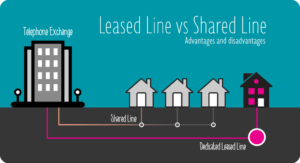Broadband.
Which is the right choice for your business?

In this weeks Tech Tuesday article, I will explain the differences between various business broadband options and which is best for your business. The main options are FTTC, EoFTTC and Leased Lines.
What is FTTC?
Basically it means Fibre to the Cabinet (FTTC) is an alternative technology that provides slower broadband speeds compared to FTTP (Fibre to the Premises).
The reason FTTC is slower than FTTP is that the fibre cables from the local exchange (or data centre) stop at the street cabinet. From here, traditional copper cabling is used to pipe the data to your router.
You may have noticed the installation of the new local cabinets, and the laying of cabling to them, over the past few years. These cabinets route data to your business, for voice and internet, via existing copper telephone wires. This kind of broadband is suitable for most small businesses, who only use broadband for emails and basic internet uses.
FTTC Pros
- Excellent coverage – more than 90% of premises can get some kind of FTTC service.
- Reasonably good download speeds that are usually sufficient for typical home use.
- Very affordable.

FTTC Cons
- Top speeds pale in comparison to other fibre solutions
- Upload speeds are limited.
- Speed impacted by the length of the copper line from the cabinet.
What is EoFTTC?
Ethernet over Fibre to the Cabinet utilises a FTTC connection to deliver an Ethernet grade service with dedicated, uncontrolled bandwidth. This means upgrading from regular broadband to business grade connection can now be achieved at a substantially lower cost in comparison to other forms of dedicated connectivity. EoFTTC can offer a lot more than standard Fibre Broadband. With the dedicated connectivity you would not be sharing bandwidth with others so speeds won’t drop during peak times.
EoFTTC can be provided with symmetrical bandwidth which means you would have equal upload and download speeds. This is important to many businesses as the increase in upload speeds can make a significant difference to running many business appilcations. FTTC upload speeds are often 10Mbps maximum whereas you can potentially double this with EoFTTC to 20mbps or possibly more.
High upload speeds will enable:
- Fast upload of large data files
- Easy adoption of Hosted ‘Cloud’ services
- Adoption of VoIP Telephony with associated cost savings
- Video Conferencing and on-line Collaboration
- Multiple data traffic – voice, data and internet
Leased Lines
Leased lines offer higher maximum speeds than EoFTTC, Leased Lines in contract can offer ‘up too 10,000Mbps’ in most areas of the UK. Where as EoFTTC use copper wiring to carry the signal for part of its journey, Leased Lines use fibre-optic cables for the whole journey. It also only offers dedicated bandwidth, where as EoFTTC tends to offer a mix of dedicated and non-dedicated.

EoFTTC will more than likely be quicker to install than a standard leased line as it piggy backs on a pre-existing telecom line, however leased line connection speeds are more predictable.
If you order a 100Mbps leased line, it’s pretty much certain you’ll get a connection that connects at 100Mbps. If you order an EoFTTC circuit, it’s less clear upfront whether you’ll be able to be sure of getting your 20Mbps.
If you’ve ordered ‘up to 80mbps’ FTTC and found you could only get, say, 60Mbps downstream and 15Mbps upstream, EoFTTC isn’t going to boost that to 20Mbps upstream, because the only real change locally is a contractual one – with your ISP paying to guarantee some backhaul capacity from your local cabinet to their network. If the physical infrastructure between you and that cabinet can’t deliver 20Mbps upstream, swapping FTTC for EoFTTC isn’t going to change that.
Leased Lines are most effective for larger businesses who need dedicated bandwidth.
Here at CoRE Educational we offer all three of these broadband options. For any advice and a personalised quote get in touch with our Account Manager, Abbygail Richardson, on 0330 22 35 229 or email at abbygail@coresupport.org.uk



